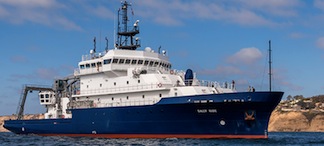The following is the text of a news release from the U.S. Navy:
(SAN DIEGO) — The Navy's auxiliary general purpose oceanographic research vessel, R/V Sally Ride (AGOR 28), was commissioned during a ceremony Oct. 28 at the Broadway Pier Port Pavilion in San Diego.
Representatives from the Navy joined elected officials and the oceanographic community to celebrate the launch of America's newest research vessel.
Oceanographer and navigator of the Navy, Rear Adm. Timothy Gallaudet, attended the day's festivities.
"As a Scripps graduate, career oceanographer and naval officer, I cannot think of a more exciting event than this commissioning," said Gallaudet. "Scripps is obtaining a capital asset; this vessel will advance our understanding of the oceans for decades, and we need this understanding in order to protect our country, our interests, and our allies."
Climate change, the study of fisheries, and understanding sound in the sea are three primary research efforts Sally Ride will explore in its upcoming travels, said Gallaudet.
The ship was named in honor of the late Sally Ride, who was selected for NASA's astronaut corps in 1978, became the first American woman in space aboard space shuttle Challenger in 1983, and later joined the faculty of the University of California, San Diego as a professor of physics.
"Sally Ride is a role model to all of us," said U.S. Rep. Susan Davis. "Her impact on women, girls, and generations of students is far-reaching." Ride was an advocate for Science, Technology, Engineering, and Mathematics (STEM) outreach, inspiring and encouraging young people to pursue education and careers in the aforementioned fields.
Oceanographic research vessels provide scientists with the tools and capabilities to support ongoing research across the globe, gaining a better understanding of the world's oceans, atmosphere, and solid earth to solve some of the planet's most pressing challenges.
Sally Ride is based on a single-hull commercial design; it measures approximately 238 feet long and incorporates the latest technologies, including high-efficiency diesel engines, emissions controls for stack gasses, and new information technology tools both for monitoring shipboard systems and for communicating with the world.
The ship will be operated by the Scripps Institution of Oceanography under a charter party agreement with the Office of Naval Research. The vessel has accommodations for 24 scientists and will operate with a crew of 20 personnel.
This is the second ship of its class built by Dakota Creek Industries. The shipbuilder also constructed R/V Neil Armstrong (AGOR 27), delivered to the Navy in September 2015.

